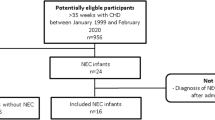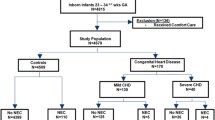Abstract
We aimed to investigate the role of hypoxia-ischemia in the pathophysiology of early NEC/NEC like disease (ENEC) and classic NEC/NEC like disease (CNEC) in preterm infants. In this pilot study, preterm infants who developed the clinical symptoms and signs of NEC/NEC like disease were divided into two groups as early (≤ 7 days, ENEC) or late (> 7 days, CNEC) groups. Beside clinical variables, serum L-lactate, endothelin-1 (ET-1), platelet activating factor (PAF), and intestinal fatty acid binding protein (I-FABP) levels were measured from umbilical/peripheric venous blood in the first hour of life and during the clinical presentation in all groups. A total of 86 preterm infants were enrolled in the study. In the ENEC group, the incidences of fetal umbilical artery Doppler velocimetry abnormalities, IUGR, and delayed passage of first meconium were higher. In addition, mean levels of L-lactate, ET-1, PAF, and I-FABP were higher in the first hour of life.
Conclusion: Our study firstly showed that the dominant pathophysiological factor of ENEC is prenatal hypoxic-ischemic event where intestinal injury and inflammation begin in-utero and become clinically apparent in the first week of life. Therefore, we propose a new term “Hypoxic-Ischemic Enterocolitis (HIEnt)” for the definition of ENEC in preterm infants with prenatal hemodynamic disturbances and IUGR. This new sight can provide individualized preventive and therapeutic strategies for preterm infants.
What is Known: | |
• The pathophysiology of early necrotizing enterocolitis (NEC) or NEC-like disease which is seen in the first week of life seems different than classic necrotizing enterocolitis (CNEC) which is always seen after the first week of life. | |
What is New: | |
• This study suggests that perinatal hypoxic-ischemic process with inflammation is the point of origin of fetal intestinal injury leading to ENEC. | |
• We propose a new term “Hypoxic-Ischemic Enterocolitis (HIEnt)” for the definition and differentiation of this unique clinical entity. |
Similar content being viewed by others
Abbreviations
- AREDF:
-
absent or reversed end-diastolic blood flow
- CNEC:
-
classic necrotizing enterocolitis
- ENEC:
-
early necrotizing enterocolitis
- ET-1:
-
endothelin-1
- I-FABP:
-
intestinal fatty acid binding protein
- IUGR:
-
intrauterine growth restriction
- NEC:
-
necrotizing enterocolitis
- NICU:
-
neonatal intensive care unit
- PAF:
-
platelet activating factor
References
Neu J, Walker A (2011) Necrotizing enterocolitis. N Engl J Med 364:255–264. https://doi.org/10.1056/NEJMra1005408
Gordon PV, Swanson JR (2014) Necrotizing enterocolitis is one disease with many origins and potential means of prevention. Pathophysiology 21:13–19. https://doi.org/10.1016/j.pathophys.2013.11.015
Neu J (2014) Necrotizing enterocolitis: the mystery goes on. Neonatology 106:289–295. https://doi.org/10.1159/000365130
Yee WH, Soraisham AS, Shah VS, Aziz K, Yoon W, Lee SK, Network CN (2012) Incidence and timing of presentation of necrotizing enterocolitis in preterm infants. Pediatrics 129:e298–e304. https://doi.org/10.1542/peds.2011-2022
Clark DA, Munshi UP (2014) Feeding associated neonatal necrotizing enterocolitis (primary NEC) is an inflammatory bowel disease. Pathophysiology 21:29–34. https://doi.org/10.1016/j.pathophys.2013.11.006
Chen AC, Chung MY, Chang JH, Lin HC (2014) Pathogenesis implication for necrotizing enterocolitis prevention in preterm very-low-birth-weight infants. J Pediatr Gastroenterol Nut 58:7–11. https://doi.org/10.1097/MPG.0b013e3182a7dc74
Nowicki PT (2005) Ischemia and necrotizing enterocolitis: where, when, and how. Semin Pediatr Surg 14:152–158. https://doi.org/10.1053/j.sempedsurg.2005.05.003
Martinez-Tallo E, Claure N, Bancalari E (1997) Necrotizing enterocolitis in full-term or near-term infants: risk factors. Biol Neonate 71:292–298. https://doi.org/10.1159/000244428
Tarrado X, Castanon M, Thio M, Valderas JM, Aparicio LG, Morales L (2005) Comparative study between isolated intestinal perforation and necrotizing enterocolitis. Eur J Pediatr Surg 15:88–94. https://doi.org/10.1055/s-2004-821255
Gordon PV (2009) Understanding intestinal vulnerability to perforation in the extremely low birth weight infant. Pediatr Res 65:138–144. https://doi.org/10.1203/PDR.0b013e31818c7920
Bozzetti V, Tagliabue PE (2017) Enteral feeding of intrauterine growth restriction preterm infants: theoretical risks and practical implications. Pediatr Med Chir 39:160. https://doi.org/10.4081/pmc.2017.160
Bora R, Mukhopadhyay K, Saxena AK, Jain V, Narang A (2009) Prediction of feed intolerance and necrotizing enterocolitis in neonates with absent end diastolic flow in umbilical artery and the correlation of feed intolerance with postnatal superior mesenteric artery flow. J Matern Fetal Neonatal 22:1092–1096. https://doi.org/10.3109/14767050903029600
Gordon PV, Swanson JR, MacQueen BC, Christensen RD (2017) A critical question for NEC researchers: can we create a consensus definition of NEC that facilitates research progress? Semin Perinatol 41:7–14. https://doi.org/10.1053/j.semperi.2016.09.013
Block T, Nilsson TK, Björck M, Acosta S (2008) Diagnostic accuracy of plasma biomarkers for intestinal ischemia. Scand J Clin Lab Invest 68:242–248. https://doi.org/10.1080/00365510701646264
Young C, Sharma R, Handfield M, Mai V, Neu J (2009) Biomarkers for infants at risk for necrotizing enterocolitis: clues to prevention? Pediatr Res 65:91R–97R. https://doi.org/10.1203/PDR.0b013e31819dba7d
Evennett N, Alexander N, Petrov M, Pierro A, Eaton S (2009) A systematic review of serologic tests in the diagnosis of necrotizing enterocolitis. J Pediatr Surg 44:2192–2201. https://doi.org/10.1016/j.jpedsurg.2009.07.028
Walsh MC, Kliegman RM (1986) Necrotizing enterocolitis: treatment based on staging criteria. Pediatr Clin North Am 33:179–201. https://doi.org/10.1016/s0031-3955(16)34975-6
Fenton TR (2003) A new growth chart for preterm babies: Babson and Benda's chart updated with recent data and a new format. BMC Pediatr 3:13. https://doi.org/10.1186/1471-2431-3-13
Bahado-Singh RO, Kovanci E, Jeffres A, Oz U, Deren O, Copel J, Mari G (1999) The Doppler cerebroplacental ratio and perinatal outcome in intrauterine growth restriction. Am J Obstet Gynecol 180:750–756. https://doi.org/10.1016/s0002-9378(99)70283-8
Arnoldi R, Leva E, Macchini F, Di Cesare A, Colnaghi M, Fumagalli M, Mosca F, Torricelli M (2011) Delayed meconium passage in very low birth weight infants. Eur J Pediatr Surg 21:395–398. https://doi.org/10.1055/s-0031-1291301
Frost BL, Jilling T, Caplan MS (2008) The importance of pro-inflammatory signaling in neonatal necrotizing enterocolitis. Semin Perinatol 32:100–106. https://doi.org/10.1053/j.semperi.2008.01.001
Mannoia K, Boskovic BS, Slater L, Plank MS, Angeles DM, Gollin G (2011) Necrotizing enterocolitis is associated with intestinal injury. J Pediatr Surg 46:81–85. https://doi.org/10.1016/j.jpedsurg.2010.09.069
Dorling J, Kempley S, Leaf A (2005) Feeding growth restricted preterm infants with abnormal antenatal Doppler results. Arch Dis Child Fetal Neonatal Ed 90:F359–F363. https://doi.org/10.1136/adc.2004.060350
Bozzetti V, Tagliabue PE, Visser GH, van Bel F, Gazzolo D (2013) Feeding issues in IUGR preterm infants. Early Hum Dev 89(Suppl 2):S21–S23. https://doi.org/10.1016/j.earlhumdev.2013.07.006
Kirtsman M, Yoon EW, Ojah C, Cieslak LSK, Shah PS (2015) Nil-per-os days and necrotizing enterocolitis in extremely preterm infants. Am J Perinatol 32:785–794
Demir IE, Ceyhan GO, Friess H (2012) Beyond lactate: is there a role for serum lactate measurement in diagnosing acute mesenteric ischemia? Dig Surg 29:226–235. https://doi.org/10.1159/000338086
Nowicki PT, Dunaway DJ, Nankervis CA, Giannone PJ, Reber KM, Hammond SB, Besner GE, Caniano DA (2005) Endothelin-1 in human intestine resected for necrotizing enterocolitis. J Pediatr 146:805–810. https://doi.org/10.1016/j.jpeds.2005.01.046
Caplan MS, Simon D, Jilling T (2005) The role of PAF, TLR and the inflammatory response in neonatal necrotizing enterocolitis. Semin Pediatr Surg 14:145–151. https://doi.org/10.1053/j.sempedsurg.2005.05.002
Thuijls G, Derikx JP, van Wijck K, Zimmermann LJ, Degraeuwe PL, Mulder TL et al (2010) Non-invasive markers for early diagnosis and determination of the severity of necrotizing enterocolitis. Ann Surg 251:1174–1180. https://doi.org/10.1097/SLA.0b013e3181d778c4
Neu J, Modi N, Caplan M (2018) Necrotizing enterocolitis comes in different forms: Historical perspectives and defining the disease. Semin Fetal Neonatal Med 23:370–373. https://doi.org/10.1016/j.siny.2018.07.004
Markiet K, Szymanska-Dubowik A, Janczewska I, Domazalska-Popadiuk I, Zawadzka-Kepczynska A, Bianek-Bodzak A (2017) Agreement and reproducibility of radiological signs in NEC using the duke abdominal assessment scale (DAAS). Pediatr Surg Int 33:335–340. https://doi.org/10.1007/s00383-016-4022-y
Acknowledgment
We thank Professor Pinar Erkekoglu for performing ELISA analysis.
Funding
This study was supported by Hacettepe University (Research Grant No: 011 D04 101008)
Author information
Authors and Affiliations
Contributions
Dr. Surmeli Onay organized the data collection, carried out the initial analyses, drafted the initial manuscript.
Dr. Korkmaz conceptualized and designed the study, proposed the new terminology, controlled the analyses, drafted the first and final manuscripted as submitted.
Drs Yigit and Yurdakok reviewed the manuscript and approved the final manuscript as submitted.
Corresponding author
Ethics declarations
Conflict of interest
The authors declare that they have no conflicts of interest.
Ethical approval
The Institutional Ethics Committee approved the study (No: HEK 10/91).
Informed consent
Informed consent forms were received from all parents before inclusion in the study.
Additional information
Communicated by Patrick Van Reempts
Publisher’s note
Springer Nature remains neutral with regard to jurisdictional claims in published maps and institutional affiliations.
Rights and permissions
About this article
Cite this article
Surmeli Onay, O., Korkmaz, A., Yigit, S. et al. Hypoxic-ischemic enterocolitis: a proposal of a new terminology for early NEC or NEC-like disease in preterm infants, a single-center prospective observational study. Eur J Pediatr 179, 561–570 (2020). https://doi.org/10.1007/s00431-019-03539-w
Received:
Revised:
Accepted:
Published:
Issue Date:
DOI: https://doi.org/10.1007/s00431-019-03539-w




